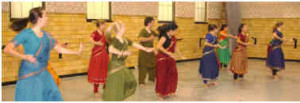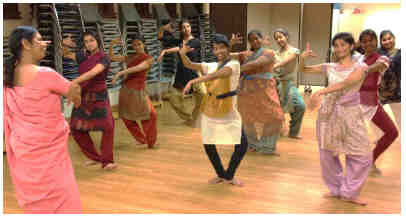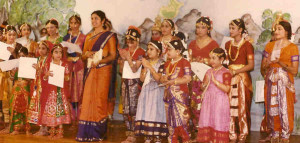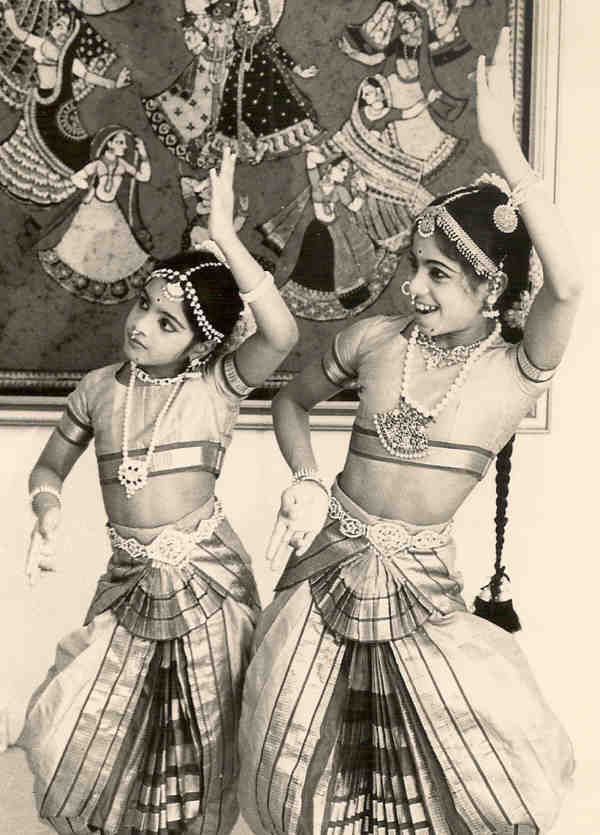By S. V. Krishnaswamy, Baltimore, MD
e-mail: krish15146@yahoo.com
Editor’s Note: S. V. Krishnsawamy lived in Monroeville for very many years before moving to Maryland. He interviewed Jaya Mani for the Patrika in 2003. He talked to Jaya recently on her 100th Arangetram on various subjects seemingly disjointed, but all related to, arangetrams.
Seeing one hundred students through their arangetrams is an achievement for any dance teacher anywhere. More so in the Pittsburgh metro area with barely 15,000 Indians. In June, Jaya’s 100th student had her arangetram. Thirty-five years ago, in 1971 with help from Rajashri Rajgopal (who lives in Northern Virginia now), Jaya started teaching Bharatanatyam with six students. Now, with over six dance teachers here, Jaya continues with over 100 students, taking three to four students to arangetram every year. It has been a long and exhilarating journey for Jaya. That her students trace their heritage to almost every part of India is a testimony to Jaya Mani as a teacher.
Seamlessly Integrating Technologies: These days Jaya encourages her students getting ready for arangetram to do their own web searches to get the details of the ragam, talam, composer and other information about the songs. Then she explains the meaning of the lyrics, their background and context. This allows them to be better prepared than before the advent of the web resources.
Grooming Future Teachers: When asked if she is grooming any of her students to become a teacher, Jaya says, “Some students after arangetrams continue with advanced lessons from me. If they have the commitment and the rigor to teach, I encourage them. One of my students, Shobita Ravi, is teaching in Wexford.”
Before coming to the US, Jaya taught her niece Bharatanatyam in Chennai. After arangetram, her niece studied nattuvangam (the Tamil technical term for choreography) in the Iyal Isai Nataka Manram in Chennai. She is teaching Bharatanatyam in Melbourne, Australia, where her first student’s arangetram is coming soon. Jaya will be presiding over her first grand-student’s arangetram there. Another milestone for Jaya.
Preserving the Dance Repertoire: Jaya tries to preserve the arangetram music and actual performance by converting old audio & video cassettes into DVDs, MP3, I-tunes etc. She was disappointed that several old tapes were spoiled in storage. Asked if she is planning to make her collection of music available for young teachers, Jaya says she is willing to make them available for her students if they are is serious about using them in any performance.
Jaya became emotional recalling that her father, who supported her throughout her dancing career, saw several of her students’ arangetrams in person in Pittsburgh.
Challenges in Using Live Music: “I have accomplished most of what I set out for myself when I started teaching three decades ago,†She says, “My only disappointment is that I am not able to routinely incorporate live orchestra in arangetrams.†This is because of the logistical constraints and the winter weather. She lives in Slippery Rock, more than an hour’s drive from Pittsburgh. However, she is happy that she supports musicians in Chennai using their recorded music in arangetrams.
With so many arangetrams completed, her students have a number of dance dresses and jewelry. When asked what they do with these when they no longer need them, Jaya admits, “It is the parents’ decision. Some want to keep them as souvenirs, and some lend them for other children.” Some parents and Jaya herself, have lent the dresses to students going through arangetrams.
On the General Baharatanatyam Scene Today: Isai velalar nattuvanars (choreographers in Tamil), have composed superb varnams, padams and tillanas for dance. Nattuvanars were all men—the term is masculine in Tamil. Till the mid-20th century, nattuvanars held a pre-eminent place in arangetrams. However, with the mostly English-educated upper class women taking over choreography, we witness the decline of nattuvanars. They are replaced by those who do only the Sollu-kattu, and yet are said to do nattuvangam! Now he/she is one in the music ensemble instead of being at the center of the dance program.
However, veterans like Adyar Lakshmanan, C V Chandrasekhar, the Dhananjayans, Narasimhacharis, and K J Sarasa carry on the old-time nattuvangam. Similarly, even though dancers like Balasaraswathy, Rukmini Devi, and Padma Subramaniam have composed Varnams and Padams, they are rare. Today’s mostly English-educated choreographers do not have the skills — Indian languages, grasp of history and mythologies, epics, philosophy, and literary skills and poetical talent — required to compose lyrics. So, I asked Jaya, “What is the contribution of today’s choreographers for the dance repertoire?”
While recognizing the lack of compositions by dance teachers/choreographers themselves, Jaya is confident the young composers will fill the gap. She gave an example of her interaction years ago with a young violinist who composed music for her using the works from Tamil Bhakti literature and from contemporary poets. He is B V Raghavendra Rao, a leading violinist now. Jaya feels modern-day choreographers need to identify such talents and work with them.
“Why is that today’s dance teachers are reluctant to use the excellent classically tuned film songs by poets like Udumalai Narayana Kavi, Pattukkottai Kalyanasundaram, Kannadasan, and others in recitals?”
Jaya: “If the music and lyrics suit the dance theme, then surely one can use their songs.” She gave examples of lyrics of film songs she helped her students to use for fundraising events.
Taking Bharatanatyam to Universities Here: Jaya is now teaching Bharatanatyam at the Slippery Rock University one semester a year. Â In her class typically over thirty American students register.

“What can anyone can learn in one semester?” I asked.
Jaya unhesitatingly says, “These are dedicated dance majors. They quickly grasp the basic adavus, jatis and learn alarippu, kolattam and few basic dance pieces in one semester.” Continuing, she said, “These students go to Chennai during the summer to get immersed in the Indian dance scene there under the guidance of Revathy Ramachandran.â”
On Saturday, June 15, Jaya’S students celebrated her contributions to our community in a function held at the S.V. Temple.
We congratulate Jaya for implanting the nuances of Indian performing arts in the minds of our youngsters born and raised here, not an easy task by any means. We also thank her for nurturing in our youngsters the culture, and the very core of our faith that is woven into the dance repertoire. We wish her well for many more arangetrams.
=========================



